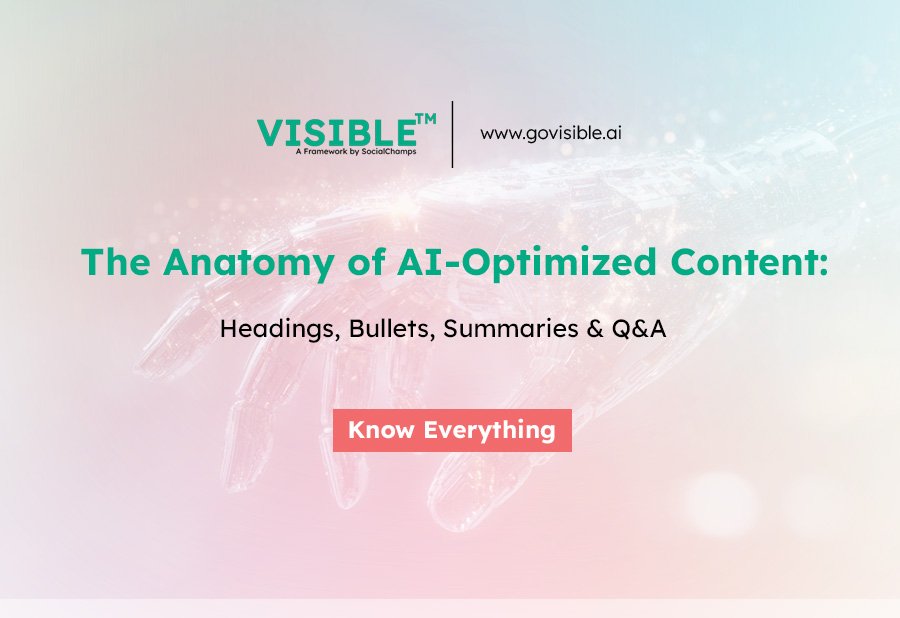What Is AI-Optimized Content?
AI-Optimized Content is structured, machine-readable digital content engineered to be indexed, interpreted, and prioritized by large language models (LLMs) and search algorithms. At VISIBLE™, we define it as the foundation of Generative Engine Optimization (GEO) — not just content that ranks, but content designed for retrieval, reuse, and reasoning by AI.
The Rise of LLM-Ready Content
In a search environment increasingly influenced by AI-generated answers (ChatGPT, Gemini, Perplexity, and Search Generative Experience), traditional keyword stuffing no longer guarantees discoverability. Structured formats — headers, bullets, summaries, and Q&A — act as semantic markers. They serve as prompt-predictive scaffolding for AI crawlers.
“Structured content can increase crawl efficiency by 30%” – Google Search Central
Structured vs. Unstructured: Why It Matters
Unstructured blogs often meander — paragraphs stacked without hierarchy. In contrast, structured content segments intent. That makes it digestible to humans and interpretable by LLMs. It’s the difference between reading and indexing. Structure gives AI models a roadmap.
Content Hierarchy That Works
Headings (H1-H3): Signposts for AI
Think of H1-H3 tags as directional compasses. They signal semantic shifts. H1 defines the document’s purpose. H2s guide topic flow. H3s refine detail. Each heading acts as a breadcrumb for crawling algorithms.
Example:
- H1: The Anatomy of AI-Optimized Content
- H2: Content Hierarchy That Works
- H3: Headings as Signposts for AI
Structured headings increase the Entity Depth Index — how deeply a topic is explored across interconnected subtopics.
Bullets: Scannability for Human + Machine
Bullet lists provide syntactic predictability. For LLMs, they offer consistent parsing structures. For users, they reduce cognitive load.
Best Practice:
- Use parallel sentence structure.
- Limit to 3–7 points.
- Keep phrasing concise.
HubSpot’s product comparison pages are bullet-dense, making them snippet-friendly and LLM-trainable.
Summaries: Distilled Value for Snippets and Models
A summary isn’t a teaser — it’s a compression engine. AI uses it as a decoding primer. Placing a summary after an H1 or H2 improves retrieval.
The VISIBLE™ Platform flags content missing summary modules in audits and recommends adding 2–3 sentence TL;DR blocks.
Q&A: Schema-Ready and LLM-Trainable
Q&A formats map cleanly to schema.org standards. For LLMs, they resemble prompt-answer pairs — crucial training assets.
Pro Tip: Tag each Q&A with structured data. The VISIBLE™ Platform auto-detects and scores Q&A sections for LLM training potential.
Examples from SaaS, Consumer, and B2B Brands
- Zapier’s blog uses Q&A and summaries extensively — leading to frequent SGE feature.
- Notion’s Help Center uses bullet lists and modular headings, optimized for semantic parsing.
- Adobe’s tutorials begin with task-based summaries, enhancing both SEO and generative answer inclusion.
Breakdown of a Perfectly Structured Blog
- H1: Clear, keyword-aligned title
- Intro Summary: TL;DR with value proposition
- H2/H3s: Logical, nested subheadings
- Bullets: Compact key takeaways or steps
- Q&A Section: At end or inline
How the VISIBLE™ Platform Implements It
The VISIBLE™ Platform auto-tags structural elements and scores them using our proprietary Visibility Score — a composite metric of structural depth, AI readability, and modularity.
Upcoming features will:
- Suggest summary placements
- Recommend bullet conversions from longform
- Flag missing Q&A patterns
From Structure to Search: GEO in Action
How This Feeds LLM Indexes
Structured content creates reusable Prompt Bank material. A well-formatted Q&A can become a retrieval-ready answer. A clean summary becomes a chunk in a vector index.
Better Rankings, Better Retrieval, Better ROI
Crawlability and interpretability = visibility.
- Better snippet inclusion
- Higher featured placement in generative answers
- Faster index updates
Future-Proofing Content Strategy
“Structure isn’t optional anymore. With LLMs now setting the indexation agenda, brands that fail to structure will fail to scale. Our job at VISIBLE™ is to systematize content visibility — block by block.”
— Co-Founder, VISIBLE™
Audit Your Structure with the VISIBLE™ Platform

